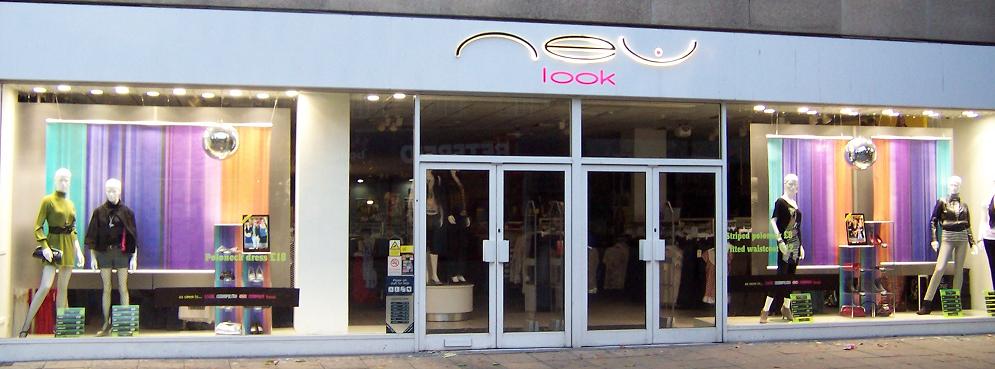In a dramatic twist for one of Ireland’s well-known high-street names, New Look has initiated a process that will see the closure of 26 of its stores across the Republic, as the fashion retailer embarks on a liquidation process. The decision, which has sparked widespread concern among staff and industry observers alike, marks a significant turning point for the brand’s presence in Ireland—a market it entered back in 2003. With approximately 350 jobs potentially at risk and an uncertain future looming, the news has sent ripples through the retail sector and raised critical questions about the challenges facing traditional brick-and-mortar operations in today’s volatile economic climate.
A Storied History Meets a Changing Retail Landscape
For nearly two decades, New Look has been a familiar name on Irish high streets, offering trendy fashion at accessible prices. However, over the past several years, the retailer has struggled under a weight of sustained losses and a rapidly evolving market. A combination of rising in-market costs, persistent supply-chain disruptions, and a dramatic shift in consumer spending habits have all contributed to mounting pressures that the company could no longer withstand. As a result, the decision to wind down its Irish operations was seen not as an abrupt misstep, but as the culmination of a series of challenging developments.
The liquidation process, approved by the High Court in Ireland last Thursday, signals the start of a phased exit from the market. Provisional liquidators have been appointed to oversee the closure, with an immediate plan to reopen the affected stores for a liquidation sale this past Sunday. This clearance event offers one final opportunity for bargain-hungry shoppers to take advantage of steep discounts, even as it marks the beginning of the end for New Look’s physical presence in Ireland.
The Human Cost: Impact on Employees and Local Communities
At the heart of the liquidation are the people whose lives will be most directly affected. New Look employs a total of 347 staff members across its Irish network—a number that is set to dwindle as part of a planned collective redundancy process. Although the company’s public statements suggest that it remains committed to supporting its workforce during the transition, the reality for many employees is one of uncertainty and anxiety.
A formal 30-day staff consultation process is slated to commence in the coming days, during which affected workers will have the chance to engage with management and discuss their options. Yet, despite these measures, many remain deeply concerned about the potential for significant job losses. With around 350 roles estimated to be at risk, the closures are likely to have a profound impact not only on the individuals directly employed by New Look but also on the broader local communities that have long benefited from the retailer’s presence.
The Irish Labour Party has been quick to voice its discontent over the decision. George Lawlor, the party’s enterprise spokesman, stressed the urgent need for the company to adopt a more empathetic and transparent approach in its handling of the redundancies.

The Legal and Financial Process Unfolds
The appointment of provisional liquidators by the High Court represents a critical juncture in the winding-down process. This legal intervention is designed to ensure that the liquidation is managed in an orderly and transparent manner, with the interests of all stakeholders—employees, creditors, and customers—taken into account. Although the decision was not made lightly, it reflects the grim reality facing the company after years of operating in an increasingly inhospitable market environment.
In practical terms, the liquidation process will involve a comprehensive review of New Look’s Irish operations, with the liquidators tasked with overseeing the sale of assets, the settlement of debts, and the eventual dissolution of the local business. While this process is expected to take some time, the immediate impact is already being felt in the form of the clearance sale, which has seen stores temporarily reopening to allow customers to purchase remaining stock at significantly reduced prices.
Market Pressures and Strategic Realignment
The decision to close the Irish stores comes amid a broader strategic realignment by the New Look Group. With trading conditions growing ever more volatile, the company has opted to concentrate its future investments on its core UK operations and its burgeoning digital offering. Following this review, we regrettably concluded that it was no longer viable to continue trading here. It has been a difficult but necessary decision.”
The shift in focus highlights a wider trend within the retail industry. As consumer habits evolve—with more shoppers turning to online platforms for convenience and competitive pricing—traditional high-street retailers have found themselves under immense pressure to adapt or risk obsolescence. In New Look’s case, the financial strain induced by elevated supply-chain costs and a squeeze on consumer spending proved too challenging to overcome. Despite attempts to innovate through new marketing initiatives, store adaptations, and trials of varied price ranges, the strategic review ultimately revealed that the Irish market could no longer sustain the company’s traditional model.
The Broader Implications for the Irish Retail Sector
New Look’s liquidation is not an isolated incident. It mirrors a broader pattern of disruption in the retail industry, where changing consumer behavior and fierce online competition have forced many established brands to reconsider their physical footprint. In Ireland, as in many other countries, high-street retailers are grappling with declining foot traffic and the need to invest heavily in digital transformation.
For local economies, the closure of a prominent retailer such as New Look carries significant ramifications. The loss of nearly 350 jobs will undoubtedly have a ripple effect, potentially impacting not only the affected employees but also the supply chains and ancillary services that have supported the stores over the years. Moreover, the closure of these stores may contribute to a broader decline in high-street vibrancy, prompting concerns about the long-term sustainability of physical retail in the face of an accelerating digital revolution.
Customer Response and the Final Clearance Sale
Despite the somber undertones of the liquidation process, the clearance sale that saw the reopened stores on Sunday has drawn considerable attention from bargain hunters and loyal customers alike. Shoppers flocked to the stores in droves, eager to purchase their favorite New Look collections at dramatically reduced prices. For many, the sale represents one last opportunity to capture a piece of the brand’s legacy—an opportunity to own a tangible reminder of a retailer that has been an integral part of the local fashion scene for nearly two decades.
However, the sale also serves as a poignant reminder of the transient nature of retail trends. As New Look gradually exits the Irish market, its collections will continue to live on—but in a different form. Future purchases of the brand’s merchandise will be available through online platforms such as ASOS and Very. This shift underscores the inevitable transformation of the retail landscape, where digital channels are increasingly supplanting traditional stores as the primary avenue for consumer engagement.
Stakeholder Reactions and the Call for Accountability
The unfolding situation has prompted a variety of reactions from key stakeholders. In addition to the Irish Labour Party’s vocal criticism, trade unions and local business associations have also expressed their concerns. Many are calling for more robust measures to protect workers’ rights and ensure that the process of liquidation is handled with the utmost transparency and fairness. The consensus among these groups is clear: while financial and strategic decisions may sometimes necessitate difficult choices, the human impact of such decisions must not be overlooked.
Industry experts have noted that the liquidation of New Look’s Irish operations could serve as a bellwether for similar developments across the sector.
As New Look pivots its focus towards its UK business and digital channels, the company is also positioning itself to better navigate the uncertainties of the modern retail environment. The increased emphasis on online sales is not merely a reactive measure; it represents a strategic evolution aimed at capturing a new generation of consumers who value convenience, accessibility, and competitive pricing. Digital platforms offer a level of agility and reach that traditional brick-and-mortar stores simply cannot match, and New Look’s decision to channel investments into its online presence is reflective of a broader industry trend.
Yet, the shift to digital is not without its challenges. E-commerce, while offering significant advantages in terms of cost efficiency and customer data insights, also comes with a unique set of operational complexities—from logistics and fulfillment to cybersecurity and digital marketing. For a company that has built its reputation on high-street retail, the transition to a predominantly online model requires not only technological upgrades but also a fundamental rethinking of customer engagement strategies. In this context, New Look’s experience in Ireland may well serve as a cautionary tale for other retailers contemplating a similar digital transformation.
Analyzing the Strategic Decisions Behind the Liquidation
Looking deeper into the strategic decisions that led to the liquidation, it becomes clear that the challenges facing New Look are emblematic of broader trends within the global retail sector. The company’s Irish operations were hampered by a host of external factors—including rising operational costs, supply-chain disruptions, and a severe contraction in consumer spending. Despite numerous attempts to mitigate these pressures through various marketing initiatives and operational adjustments, the cumulative impact of these challenges ultimately rendered the market unsustainable.
A detailed review conducted by the New Look Group revealed that even aggressive strategies to boost sales and streamline operations were not enough to counteract the external headwinds. “The decision to enter liquidation was not taken lightly,” a spokesperson explained. “It came after a thorough analysis of our performance in Ireland, where we recognized that the market dynamics had shifted to a point where continuing to trade was no longer viable.” This frank admission reflects the stark realities of today’s retail environment—a landscape where even well-established brands must constantly evolve or risk being left behind.

Broader Economic Implications
Beyond the immediate impact on New Look and its employees, the liquidation of the Irish operations has broader economic implications. In many ways, the move is indicative of a larger trend of market contraction that is affecting retail sectors around the world. As consumer habits shift towards online shopping and discretionary spending tightens in response to economic uncertainty, retailers are increasingly finding it difficult to maintain the profitability of physical stores.
Furthermore, the case of New Look highlights the importance of strategic agility in today’s competitive landscape. While the company’s decision to focus on its digital offering may eventually pay dividends, the short-term disruption caused by the liquidation process underscores the critical need for proactive adaptation. Industry observers suggest that the current situation could well serve as a catalyst for other retailers to reexamine their own business models and explore innovative ways to remain relevant in a rapidly evolving marketplace.
Looking Forward: Opportunities Amid Adversity
While the news of New Look’s liquidation in Ireland is undoubtedly disheartening for many, it also presents a potential opportunity for renewal and reinvention. The retail industry is in the midst of a profound transformation, and the closure of physical stores may pave the way for more sustainable, digitally focused models of consumer engagement. For New Look, the challenge now lies in leveraging its strong brand identity and loyal customer base to succeed in a market that increasingly values online convenience over traditional shopping experiences.
The transition will not be without its hurdles, but there is a silver lining for both the company and the industry at large. As New Look consolidates its operations and channels its resources into more promising avenues, there is hope that it can emerge stronger and more agile than before. The lessons learned from the Irish experience—about the importance of innovation, operational efficiency, and customer-centric strategies—could well serve as a blueprint for future success in a post-liquidation era.
Conclusion
The liquidation of New Look’s Irish operations marks the end of an era for a retailer that once held a prominent place on Ireland’s high streets. Faced with years of sustained losses and mounting market challenges, the decision to close 26 stores and potentially cut approximately 350 jobs was driven by a need to adapt to an increasingly competitive and volatile economic environment. While the move is being managed through a formal legal process—with provisional liquidators now in place and a clearance sale already underway—it also raises critical questions about the future of traditional retail in an age of digital transformation.
As the company pivots its focus towards its UK business and online platforms, the broader retail sector will undoubtedly be watching closely. For employees and local communities, the process is fraught with uncertainty and hardship, yet it also underscores the pressing need for robust support systems and proactive measures to mitigate the human cost of corporate restructuring.
In the end, New Look’s exit from the Irish market serves as both a cautionary tale and an impetus for change. It is a story of a retail giant grappling with the realities of modern commerce—a narrative marked by both the triumphs of a once-thriving brand and the challenges of an industry in flux. As the clearance sale draws to a close and the liquidation process moves forward, the lessons of this experience will resonate for years to come, offering insights into the dynamic interplay between market forces, consumer behavior, and the relentless pace of technological innovation.
For many, the end of New Look’s physical stores in Ireland is not merely the closure of a retail chain but the conclusion of a chapter in the nation’s commercial history. It is a poignant reminder that in today’s rapidly changing world, adaptability and foresight are not optional—they are essential for survival. And as the dust settles on this chapter, both industry experts and everyday consumers are left to ponder the future of retail in an era defined by constant change, digital disruption, and the ever-present need for reinvention.
Ultimately, while the immediate impact of the liquidation process is marked by loss and uncertainty, it may also pave the way for a new beginning—one in which New Look, along with the broader retail community, embraces the challenges of the digital age and charts a path toward a more innovative and resilient future.




